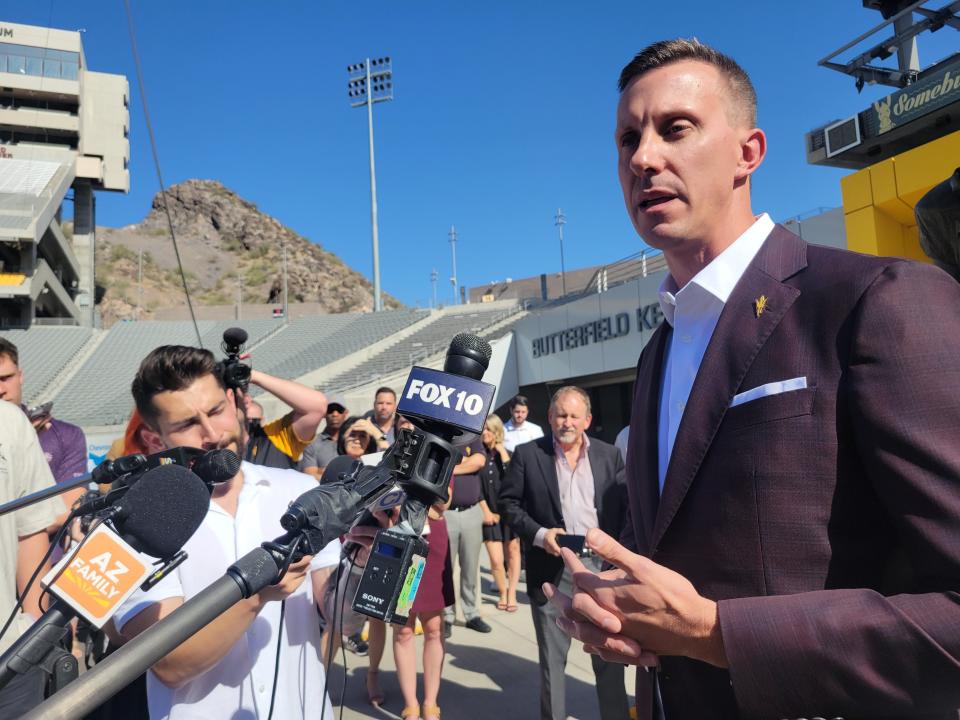Is Graham Rossini up to the challenge as Arizona State athletic director?
Graham Rossini was introduced as the new director of athletics at Arizona State on Thursday.
Rossini, 44, replaces Ray Anderson, who stepped down in November with three years left on his contract. The Rossini appointment has polarized a fan base already on edge. Rossini is an alumnus of ASU, having graduated in 2002 and he has spent a lot of years working for the Sun Devils in a couple of stints, with some time in the Arizona Diamondbacks organization in between.
Many like that it will be a product of the school trying to steer the athletic department out of the abyss. Can he do what another alumnus Kenny Dillingham has done with the football program? That's changed the trajectory and the negativity around the program. A product of the program is going to have a more vested interest in trying to get things right than an outsider and at least he already understands the landscape as far as what he is dealing with and the obstacles that lie ahead.

Then there is the other side of the fan base that wanted to see a clean break from the previous regime headlined by Anderson and former football coach Herm Edwards. The fact that President Michael Crow didn't seem to consider outside candidates has further irritated long-time supporters.
Let's take a look at the challenges Rossini will be facing as he takes the lead in a year in which the Sun Devils and three other Pac-12 schools will be transitioning to the Big 12. It won't be easy but he deserves the chance to right the ship.
1. Gaining the trust of the fan base
The fan base has been disenchanted with all that happened under Herm Edwards' watch and the fact that Anderson brought him here in the first place. Making matters worse, both walked away with lucrative windfalls while the football program and those who had no role in the NCAA rules violations were left to pay the price. So the fan base doesn't have much faith in the school's brain trust and that includes president Michael Crow, at least when it comes to athletic decisions.
So Rossini is going to have to win them back and who knows how long that will take. He appears to be well-liked and respected but the question is will Crow give him the autonomy to do what needs to be done or will he be micromanaged by Crow, whose expertise has always been more suited for academics than athletics?
2. Get major sports the resources they need to be competitive
All sports are not created equal. Look at any thriving athletic department and it's a good bet that the revenue-making sports are successful. A school needs money from those major sports to fund other sports and in the case of ASU that is even more important because it fields teams in 26 sports, more than any other school in the Big 12. That's a lot of sports to try and spread the wealth around.
ASU is coming off back-to-back 3-9 football seasons, the worst two-year spell in program history and none of that is Dillingham's fault. Men's basketball had a 23-win season two years ago but has been hit and miss and last year was a miss at 14-18, the worst season in Bobby Hurley's nine-year tenure. Women's basketball has a 19-40 record over the last two years which included a 4-32 in Pac-12 play.
And it could get tougher, particularly in men's basketball because no conference is better or more competitive than the Big 12 and yet coach Hurley's budget is a paltry one compared to his peers. It was among the bottom teams in the Pac-12 and the gap will be bigger with the move.
The baseball team was dead and buried a month ago but has had a resurgence and heads into the Pac-12 tournament hot at the right time. Meanwhile, softball finished last in the conference. All of those sports have lost key players who have hit the portal and found more lucrative spots. That brings us to the next issue.
3. Embracing and facilitating NIL issue
One of the biggest mistakes Anderson made was not getting ahead in the NIL space. In fact, it was because of him that ASU was woefully behind. It was clear that wasn't going to go away and Anderson failed to adapt with the changing times in college athletics, most notably that one thing. ASU's situation has gotten slightly better but it is still trying to play catch up and that's not a good place to be.
Athletic departments aren't supposed to be directly involved but there are ways to help bridge that process. Rossini's experience in branding and the corporate game in his tenure with the Diamondbacks should help considerably. Until significant progress is made ASU is going to keep losing marquee athletes and its coaches are going to be starting from scratch every season.
4. Dealing with Desert Financial Arena
The facility that has served as home to the school's basketball teams is outdated and barely functional and nothing has been done to remedy the situation. It has been in use since 1974 and there have been no upgrades. It was easily one of the worst in the Pac-12 and remains among the worst in all Power 5 conference facilities. Among many issues, the acoustics are downright terrible. It just doesn't make for a great fan experience.
In an interview with The Arizona Republic a year ago, Anderson acknowledged that this had to be addressed and yet another year went by when nothing was done. It remains an albatross.
This article originally appeared on Arizona Republic: 4 things will be key to the success of new ASU athletic director


